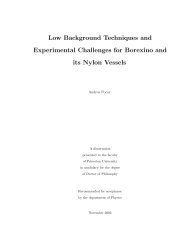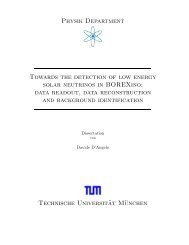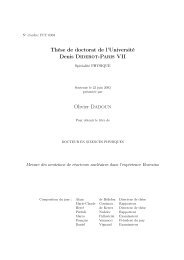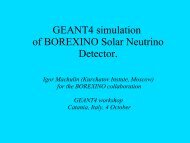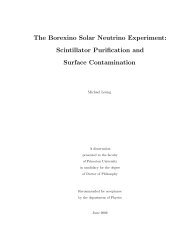Development of a Liquid Scintillator and of Data ... - Borexino - Infn
Development of a Liquid Scintillator and of Data ... - Borexino - Infn
Development of a Liquid Scintillator and of Data ... - Borexino - Infn
You also want an ePaper? Increase the reach of your titles
YUMPU automatically turns print PDFs into web optimized ePapers that Google loves.
2.4 Background<br />
- Potassium is ubiquitous with a concentration <strong>of</strong> 2.4 % in the earth’s crust. Naturally<br />
occurring K has an isotopic abundance <strong>of</strong> ¢ with a half life <strong>of</strong> ¢ years;<br />
89 % <strong>of</strong> its decays proceed by beta emission with an endpoint <strong>of</strong> 1.3 MeV <strong>and</strong> 11 %<br />
decay by electron capture with the emission <strong>of</strong> a 1.46 MeV gamma. The tolerable limit<br />
for BOREXINO is 10 g/g (KÒØ) in the scintillator. The potassium content in the fluor<br />
PPO as delivered was measured by NAA to be ¡ g/g [Gol97]. By water extraction<br />
<strong>of</strong> a concentrated solution (100 g/l PPO in PC) this could be reduced several orders<br />
<strong>of</strong> magnitude, so that the final potassium concentration in the CTF scintillator (1.5 g/l<br />
PPO in PC) was below the sensitivity limit <strong>of</strong> both the CTF ( ¡ g/g) <strong>and</strong> NAA<br />
( ¡ g/g). The purity requirement is thus not directly confirmed, but it is expected<br />
to be met because <strong>of</strong> the high efficiency <strong>of</strong> the water extraction.<br />
- Be can be formed by proton <strong>and</strong> neutron reactions on C from cosmic radiation. It<br />
decays by electron capture with a half life <strong>of</strong> 53 days, with a 10 %-branch emitting a<br />
478 keV gamma. In equilibrium at the earth’s surface Be gammas are expected to give<br />
a count rate <strong>of</strong> 2700 per day <strong>and</strong> ton <strong>of</strong> scintillator [Vog96]. This rate can be reduced by<br />
bringing the scintillator underground directly after distillation, before the equilibrium<br />
rate <strong>of</strong> Be is reached (after one day <strong>of</strong> surface exposure the expected gamma rate is<br />
per day <strong>and</strong> ton), <strong>and</strong> storing the scintillator underground for a sufficient period <strong>of</strong><br />
time to allow the Be to decay, or by removing the Be through purification. At a small<br />
rate, Be will also be produced on site by cosmic ray muons (see paragraph 2.4.3).<br />
Though there is no clear signature for a single neutrino event, there are several methods to<br />
discriminate certain classes <strong>of</strong> background events:<br />
- correlated events: the method consists <strong>of</strong> tagging delayed coincidences in the U <strong>and</strong><br />
Th decay chains ( Bi- Po, ¬-« with t s; Bi- Po, ¬-« with t <br />
Isotope Abundance T [a] Concentration [g/g]<br />
Cd 12.2 % ¡<br />
In 95.8 % ¡<br />
K 0.01 % ¡<br />
<br />
<br />
¡<br />
¡<br />
¡<br />
La 0.09 % ¡ ¡<br />
Lu 2.59 % ¡ ¡<br />
Rb 27.8 % ¡ ¡<br />
Th 100 % ¡ ¡<br />
U 99.3 % ¡<br />
Table 2.2: Trace element concentrations at an equal amount <strong>of</strong> 1 event/(100t day) to the background<br />
rate in BOREXINO in the energy range from 250 - 800 keV, after application <strong>of</strong> all cuts<br />
(correlated events, «/¬ discrimination, statistical subtraction).<br />
<br />
¡<br />
<br />
<br />
<br />
<br />
<br />
<br />
31



